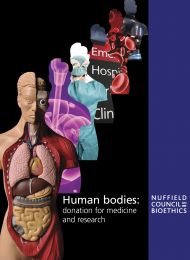Human bodies: donation for medicine and research
Report
Published 10/10/2011

A key aim for policy makers in this complex and sensitive area must be to find areas of consensus. This involves identifying values shared by many different people, even if sometimes for different reasons.
We conclude
The state should have a ‘stewardship’ role with respect to donation. This means it should work to improve general public health, and so reduce the demand for bodily material. It should help make donation as easy as possible, and take steps to remove inequalities that affect disadvantaged groups or individuals.
Altruism should continue to play a central role in ethical thinking about donation. The idea of altruistic donation – giving bodily material because another person needs it – underpins a communal and collective approach where generosity and compassion are valued.
However, an altruistic basis for donation does not necessarily exclude other approaches. Systems based on altruism and systems involving some form of payment are not mutually exclusive. We distinguish between two different kinds of action to promote donation:
- altruist-focused interventions that remove disincentives from, or provide a spur to, those already inclined to donate; and
- non-altruist-focused interventions, where the reward offered to the potential donor is intended alone to be sufficient to prompt them to donate.
Non-altruist-focused interventions are not necessarily unethical but may need to be subject to closer scrutiny because of the threat they may pose to wider communal values.
Donation for research purposes may differ in important ways from donation for treatment purposes. In particular, the contribution that any one research donor or healthy volunteer makes to the health of another person is very hard to pin down, whereas material donated for treatment benefits another individual directly. Research donors may wish to contribute to the common good without necessarily seeing this as an ‘altruistic’ act.
We take seriously concerns that, in some circumstances, payment for bodily material may lead to people’s body parts being seen as ‘things’ that can simply be bought or sold. We do not take the view that every form of payment for donation implies this. However, we reject the concept of the sale and purchase of bodily material, where money exchanges hands in direct return for body parts (rather than to reward or recompense donors for their act of donation).
The welfare of the donor, and the potential for harm and exploitation within donation practices, should be the most important consideration when deciding whether a particular system for encouraging people to donate is ethically acceptable.
Decisions about deceased donation should be based on the known wishes of the donor, so far as these can be discovered. However, instead of using the term ‘consent’, we suggest using ‘authorisation’ or ‘willingness to donate’ to distinguish between the different risks involved in donating during life and after death, and hence the different requirements for information about the procedures involved.
Values such as trust and respect play an essential part in creating systems in which people will be willing to donate. For example, potential donors must be able to trust that professionals will respect their confidentiality, and that their donated materials will be used for the purposes for which they were donated.

Share